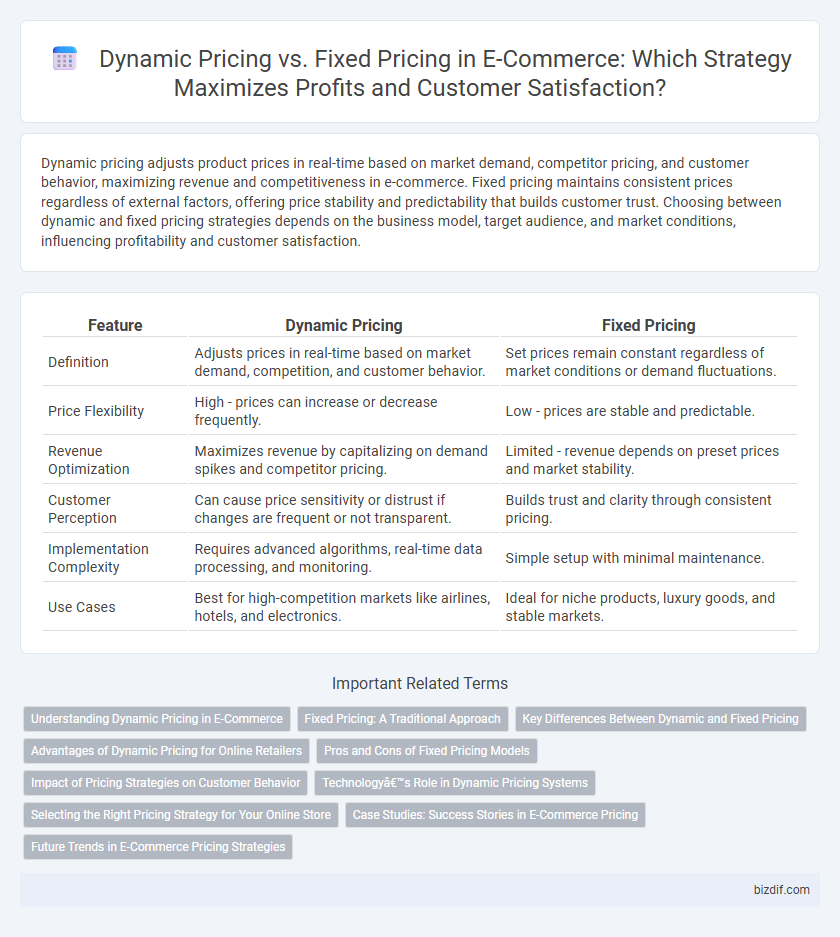Dynamic pricing adjusts product prices in real-time based on market demand, competitor pricing, and customer behavior, maximizing revenue and competitiveness in e-commerce. Fixed pricing maintains consistent prices regardless of external factors, offering price stability and predictability that builds customer trust. Choosing between dynamic and fixed pricing strategies depends on the business model, target audience, and market conditions, influencing profitability and customer satisfaction.
Table of Comparison
| Feature | Dynamic Pricing | Fixed Pricing |
|---|---|---|
| Definition | Adjusts prices in real-time based on market demand, competition, and customer behavior. | Set prices remain constant regardless of market conditions or demand fluctuations. |
| Price Flexibility | High - prices can increase or decrease frequently. | Low - prices are stable and predictable. |
| Revenue Optimization | Maximizes revenue by capitalizing on demand spikes and competitor pricing. | Limited - revenue depends on preset prices and market stability. |
| Customer Perception | Can cause price sensitivity or distrust if changes are frequent or not transparent. | Builds trust and clarity through consistent pricing. |
| Implementation Complexity | Requires advanced algorithms, real-time data processing, and monitoring. | Simple setup with minimal maintenance. |
| Use Cases | Best for high-competition markets like airlines, hotels, and electronics. | Ideal for niche products, luxury goods, and stable markets. |
Understanding Dynamic Pricing in E-Commerce
Dynamic pricing in e-commerce uses real-time data such as competitor prices, customer demand, and inventory levels to adjust product prices instantly. This strategy enables retailers to maximize revenue by responding to market fluctuations and consumer behavior dynamically. Unlike fixed pricing, dynamic pricing leverages algorithms and machine learning to optimize profitability and enhance competitive positioning.
Fixed Pricing: A Traditional Approach
Fixed pricing remains a cornerstone in e-commerce, offering customers transparent and consistent price points that build trust and simplify purchasing decisions. This traditional approach eliminates uncertainty by maintaining stable prices regardless of fluctuations in demand or inventory levels, making it particularly effective for products with steady market demand. Retailers using fixed pricing benefit from straightforward pricing strategies that reduce the complexity of price management and enhance long-term customer loyalty.
Key Differences Between Dynamic and Fixed Pricing
Dynamic pricing adjusts product prices in real-time based on market demand, competitor rates, and customer behavior, maximizing revenue and inventory turnover. Fixed pricing maintains a consistent price point regardless of external factors, providing stability and simplicity for budgeting and customer expectations. The key difference lies in flexibility: dynamic pricing leverages data analytics for adaptive strategies, while fixed pricing relies on predetermined cost structures and profit margins.
Advantages of Dynamic Pricing for Online Retailers
Dynamic pricing enables online retailers to adjust product prices in real-time based on demand, competition, and inventory levels, maximizing revenue and profit margins. This strategy enhances market responsiveness, allowing retailers to capitalize on peak buying periods and reduce stock of slow-moving items efficiently. Data-driven price adjustments improve customer segmentation and personalized offerings, fostering increased sales and stronger competitive positioning.
Pros and Cons of Fixed Pricing Models
Fixed pricing models in e-commerce offer consistency and simplicity, which helps build customer trust and streamlines inventory management. However, these models lack flexibility to respond to market fluctuations, competitor actions, or demand changes, potentially leading to lost revenue opportunities. Retailers using fixed pricing may struggle to stay competitive in dynamic markets where price optimization drives profitability.
Impact of Pricing Strategies on Customer Behavior
Dynamic pricing adjusts product prices in real-time based on demand, competition, and customer behavior, leading to increased purchase urgency and higher conversion rates. Fixed pricing provides price consistency and builds customer trust, promoting long-term loyalty but may miss opportunities to maximize revenue during peak demand. Understanding customer sensitivity to price fluctuations is crucial for selecting the optimal pricing strategy in e-commerce environments.
Technology’s Role in Dynamic Pricing Systems
Technology enables dynamic pricing systems to analyze real-time market data, competitor prices, and consumer demand through advanced algorithms and machine learning. These systems continuously adjust prices to maximize revenue and optimize inventory by leveraging big data analytics and artificial intelligence. Cloud computing infrastructure supports scalability and rapid price updates across multiple e-commerce platforms, enhancing responsiveness and customer experience.
Selecting the Right Pricing Strategy for Your Online Store
Choosing between dynamic pricing and fixed pricing requires analyzing market demand, competitor prices, and customer behavior to maximize profitability and customer satisfaction. Dynamic pricing offers flexibility to adjust prices in real-time based on algorithms and market trends, ideal for highly competitive e-commerce sectors. Fixed pricing provides stability and simplicity, making it suitable for niche products or brand-conscious markets where price consistency builds trust.
Case Studies: Success Stories in E-Commerce Pricing
Case studies in e-commerce reveal dynamic pricing's ability to boost revenue by adjusting prices based on consumer behavior, demand, and competition, as seen in Amazon's real-time price changes resulting in higher sales volumes. Fixed pricing offers predictable cost structures, favored by brands like Apple, maintaining premium positioning and customer loyalty through consistent pricing. Success in e-commerce pricing strategies depends on aligning pricing models with market dynamics, product type, and customer expectations to maximize profitability and growth.
Future Trends in E-Commerce Pricing Strategies
Dynamic pricing in e-commerce leverages real-time data analytics and AI algorithms to adjust prices based on demand, competition, and consumer behavior, driving personalized shopping experiences. Fixed pricing remains relevant for brand consistency and customer trust, especially in niche markets and for premium products. Future trends indicate a hybrid approach, integrating dynamic pricing with blockchain for transparency and customer-centric pricing models optimized through machine learning.
Dynamic Pricing vs Fixed Pricing Infographic

 bizdif.com
bizdif.com